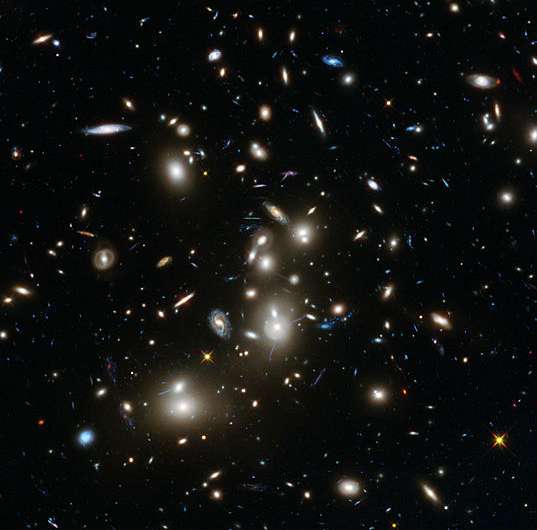January 4, 2017 report
Dozens of new ultra-diffuse galaxies discovered in Abell 2744

(Phys.org)—Astronomers have found a total of 76 new ultra-diffuse galaxies (UDGs) in the massive galaxy cluster designated Abell 2744 (also known as Pandora's Cluster). The discovery updates the current census of galaxies in this cluster and could help better understand the nature of UDGs in general. The findings were presented in a paper published Dec. 30 on arXiv.org.
UDGs are extremely-low-density galaxies. The largest UDGs have sizes similar the Milky Way but have only about one percent as many stars as our home galaxy. The mystery of UDGs is still baffling scientists as they try explain why these faint but large galaxies are not ripped apart by the tidal field of their host clusters. Furthermore, it is not clear what fraction of UDGs are "failed" giant luminous galaxies, "inflated dwarfs," or some other phenomenon.
Abell 2744 is a giant galaxy cluster located nearly 4 billion light years away in the Sculptor constellation. It is one of the most massive and most disturbed galaxy clusters known to date. Its intracluster light fraction is high and its stellar population consistent with the disruption of luminous galaxies, which makes it an excellent location to search for UDGs.
That is why a team of researchers led by Steven Janssens of the University of Toronto, Canada, has investigated Abell 2744 using data obtained with the Hubble Space Telescope (HST) Frontier Fields (FF) program. FF is known for producing the deepest images to date of galaxy clusters and gravitational lensing. The analysis of FF data allowed the astronomers to distinguish dozens of new UDGs in this giant galaxy cluster.
"We report the discovery of a large population of ultra-diffuse galaxies in the massive galaxy cluster Abell 2744 (z= 0.308) as observed by the Hubble Frontier Fields program," the researchers wrote in the paper.
As a result, the team detected 76 new UDGs—41 in the cluster field and 35 in the parallel field. They also estimated the total number of UDGs that Abell 2744 contains. According to the paper, given the fact that the analyzed data from the observations samples only a small portion of the galaxy cluster, there should be approximately 2,100 ultra-diffuse galaxies in Abell 2744. The researchers noted that this is 10 times the number of UDGs that exist in a similar cluster known as Abell 1656 (or Coma Cluster).
"Abell 2744 hosts an estimated 2133±613 UDGs, 10 times the number in Coma," the paper reads.
The research also allowed the scientists to estimate the number of ultra-compact dwarf (UCD) galaxies in Abell 2744. According to their calculations, there are about 385 UCDs in the galaxy cluster.
The researchers concluded that some UCDs in Abell 2744 may have once been nuclei or satellites of infalling UDGs, noting that the latter are ultimately destroyed by tidal forces.
"As UDGs fall in and dissolve (and, presumably, blend into the intra-cluster light), they leave behind a residue of unbound, but long-lived UCDs," the team wrote.
More information: Ultra-diffuse and Ultra-compact Galaxies in the Frontier Fields Cluster Abell 2744, arXiv:1701.00011 [astro-ph.GA] arxiv.org/abs/1701.00011
Abstract
We report the discovery of a large population of Ultra-diffuse Galaxies (UDGs) in the massive galaxy cluster Abell 2744 (z=0.308) as observed by the Hubble Frontier Fields program. Since this cluster is ~5 times more massive than Coma, our observations allow us to extend 0.7 dex beyond the high-mass end of the relationship between UDG abundance and cluster mass reported by van der Burg et al. 2016. Using the same selection criteria as van der Burg et al. 2016, A2744 hosts an estimated 2133 +/- 613 UDGs, ten times the number in Coma. As noted by Lee & Jang 2016, A2744 contains numerous unresolved compact objects, which those authors identified predominantly as globular clusters. However, these objects have luminosities that are more consistent with ultra-compact dwarf (UCD) galaxies. The abundances of both UCDs and UDGs scale with cluster mass as a power law with a similar exponent, although UDGs and UCDs have very different radial distributions within the cluster. The radial surface density distribution of UCDs rises sharply toward the cluster centre, while the surface density distribution of the UDG population is essentially flat. Together, these observations hint at a picture where some UCDs in A2744 may have once been associated with infalling UDGs. As UDGs fall in and dissolve, they leave behind a residue of unbound ultra-compact dwarfs.
© 2017 Phys.org





















